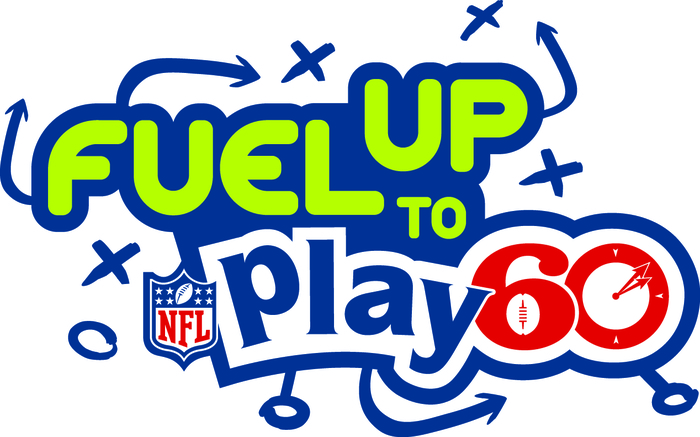Fuel Up to Play 60 en Español
Empowering Latino youth, schools, and communities to make healthy changes across the nation

Food is the fuel that provides the energy needed for physical activity and for learning.
An imbalance between energy intake and the energy used by the body can result in weight loss or weight gain. To maintain a healthy body weight, both adults and children need to achieve an energy balance, but children are also growing, and that growth needs to be considered. Body weight includes muscles, bone, fat, and water, so being overweight does not necessarily mean that a person is unhealthy or is not engaging in enough physical activity.
Unfortunately, many students in the United States do not consume healthy diets or get enough exercise. Latino youth may be at greater risk for health problems associated with unhealthy weight status, limited physical activity levels, and unhealthy eating habits.
- Today, more than 41 percent of Latino children and adolescents ages 6 to 19 in the United States are overweight or obese.
- Nearly 23 percent of Latino children are obese; in comparison, only 15 percent of White youth are obese.
- Latino youth are less likely than their White peers to get 60 minutes of physical activity each day.
- Childhood obesity and physical inactivity are likely to continue in adult life and are major risk factors for developing diabetes.
- Although about half of all U.S. students are eligible for free- and reduced-price school meals, more than 75 percent of Latino students are eligible.
- Many Latino students living in low-income households may be at risk for food insecurity because of language and other barriers.
- These health and economic disparities warrant specific attention in schools, where the Latino population (now 24 percent of all students nationwide) is on the rise.
Obesity, which involves an excessive amount of body fat, is more likely to have consequences for health than overweight. Children who are obese have a greater risk of developing high blood pressure, breathing problems, type 2 diabetes, and impaired self-esteem. They also are more likely to become obese adults who face greater risk for a number of health problems compared to adults who are not obese.
Physical activity provides many health benefits, including reduced risk for cardiovascular disease, diabetes, and some cancers. In addition, being active can strengthen bones and muscles, make it easier to maintain a healthy weight, and improve mental health and mood.
The Latino population is growing rapidly, so this is the time to tackle the dual challenges of improving diet and increasing physical activity levels among Latino children and adolescents.
Fuel Up to Play 60 is an in-school nutrition and physical activity program launched by the National Football League, the National Dairy Council, and the U.S. Department of Agriculture. Fuel Up to Play 60 is designed to engage and empower youth to take action for their own health by implementing long-term, positive changes for themselves and their schools. The U.S. Department of Health and Human Services has joined several health and nutrition organizations to partner on this important public health effort. The National Institute on Minority Health and Health Disparities (NIMHD) is helping expand the reach of Fuel Up to Play 60 among Spanish-speaking communities through the new Fuel Up to Play 60 en Español initiative, which has three goals:
- Educate Latino students, parents, and communities about the importance of healthy eating and physical activity.
- Create healthier school environments.
- Empower students to choose more healthy foods and to be active for at least 60 minutes every day.
NIMHD has designed several strategies to promote Fuel Up to Play 60 en Español through the Institute’s communications channels and networks:
- Disseminate Spanish-language materials for the program, including the new Fuel Up to Play 60 en Español website.
- Create an NIMHD webpage linking to Fuel Up to Play 60 en Español resources.
- Use social media to promote the fall 2015 Fuel Up to Play 60 en Español launch and related activities.
- Conduct outreach to organizations interested in collaborating and promoting the initiative.
NIMHD envisions an America in which all populations have an equal opportunity to live long, healthy, productive lives. To accomplish this, NIMHD raises national awareness of the prevalence and impact of health disparities and disseminates effective individual-, community-, and population-level interventions to reduce and encourage elimination of health disparities.
The following resources and websites offer additional information about how good nutrition and increased physical activity can reduce and prevent childhood obesity and overweight:
References
- Coleman-Jensen, A. G. (2014). Food Security in the United States in 2013, Statistical Supplement. Table S-3. USDA ERS.
- Eaton DK, K. L. (2010). Youth risk behavior surveillance - United States, 2009. 59:1-142.
- National Institute of Diabetes and Digestive and Kidney Diseases (NIDDK). (2012, October). Overweight and Obesity Statistics Factsheet. Retrieved October 6, 2015
- Ogden CL, C. M. (2012). Prevalence of obesity and trends in body mass index among US children and adolescents, 1999-2010. JAMA, 307(5):483-90.
- U.S. Centers for Disease Control and Prevention. (2015, June). Physical Activity and Health: The Benefits of Physical Activity. Retrieved October 6, 2015
- U.S. Centers for Disease Control and Prevention. (n.d.). National Health and Nutrition Examination Survey, 2009–2010. National Center for Health Statistics.
- U.S. Department of Education. (2015). National Center for Education Statitistics. Retrieved September 22, 2015, from

















